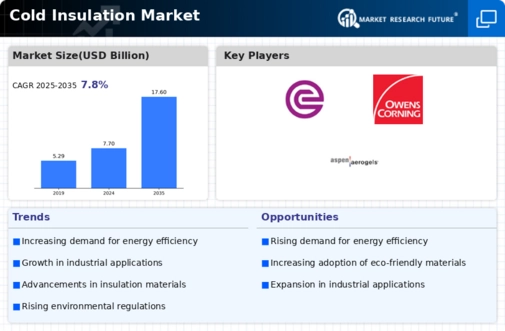Market Analysis
In-depth Analysis of Global Cold Insulation Market Industry Landscape
The Cold Insulation market can be described as a though-enabling machine through which major factors which shape the growth and development of the industry are run. The need for proper thermal insulation is a main point in this. Cold insulation materials which form a part of different sections such as foam panels, fiber logs as well as reflective protective coatings are essential to keeping temperatures down and restricting the heat transfer. Another of the mainh driving forces for shifting of the market towards the poluteration is the growing industry in the energy sector, which is mainly oil and gas.
Aside from the construction industry greatly affecting the market balance of Cold Insulating, all the other industries do. With energy efficiency getting economical as a priority area in building design, the need for proper thermal insulation in HVAC systems as well as refrigeration units and cold rooms increases. The principle of eco-friendly designs and green building only augments the importance of the improved stability with thermal insulation effectively; hence, industrial development is on the rise.
Regulation and environmental matters are among the key factors that determine the pathways of market development for Cold Insulation. Higher attention is now ruled for lower energy consumption and emissions; this has led to the increased demand for thermal insulation materials that are environmentally friendly with low thermic conductivity. Just as compliance with stringent regulations pertaining to energy conservation and adverse effects of green house gases determine the choice of insulation materials, it also inspires inventors and researchers to develop eco-friendly and efficient cold insulation technologies.
Given that cost efficiency is one of the major factors affecting the supply and demand relationships in Cold Insulation market, this aspect has to be thoroughly considered. Saving on manufactory and thermal performance is desired by both the industries and manufacturers, so balancing the cost of production and the efficacy of the products whould be considered with much importance. The key factor here is the low capital-cost strategy that producers need to adapt and that end-users will be paying for, so that this encourages innovation and in-turn, creates a competitive market.
Cold Insulation plays at the world economy stage. Economic disruptions are likely to affect construction activities, industrial projects, doing so this will evidently affect the demand since there will be no demand for cold insulation materials. Although the crucial role of these products used in applications of energy maintenance and refrigeration systems tends to serve as a stabilizing catalyst in the condition of economic uncertainties by preventing the negative impact of the latter on the market, the market is expected to keep growing.
Technologies honestly are one of the main triggers of market dynamics for cold insulation. The continuous study on new insulations materials can lead to their invention with the advancement of properties like R-value, flexibility and ease of installation among others. These technological advancements not only provide solutions to the problems that the market end-users experience, but also serve to set apart manufacturers thereby promoting the expansion of reach in novel markets.






Leave a Comment